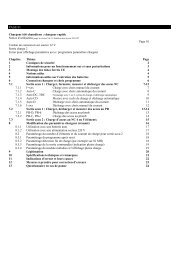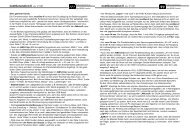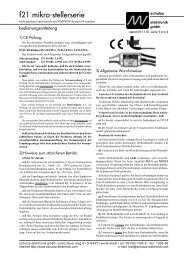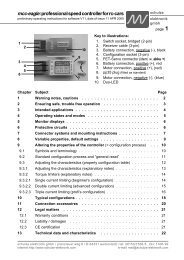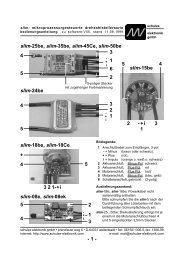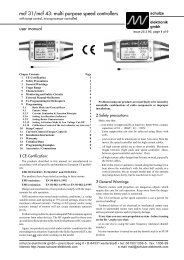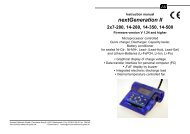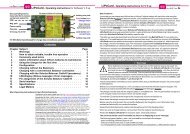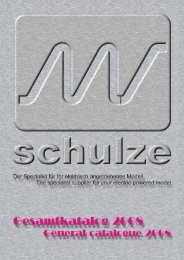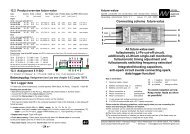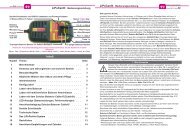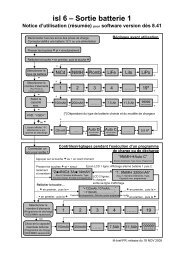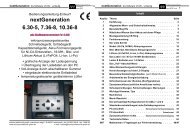ecolader: rapid discharger/charger series - Schulze Elektronik GmbH
ecolader: rapid discharger/charger series - Schulze Elektronik GmbH
ecolader: rapid discharger/charger series - Schulze Elektronik GmbH
You also want an ePaper? Increase the reach of your titles
YUMPU automatically turns print PDFs into web optimized ePapers that Google loves.
<strong>ecolader</strong>: <strong>rapid</strong> <strong>dis<strong>charger</strong></strong>/<strong>charger</strong> <strong>series</strong><br />
Operating instructions for software V1.04, date of issue 05 MAY 1998<br />
8.15.2 Auto C<br />
Purpose:<br />
Optimum program for charging batteries<br />
quickly and completely, with very few preconditions<br />
(see select criteria below).<br />
Description:<br />
The <strong>ecolader</strong> automatically calculates the<br />
ideal charge current to suit the battery.<br />
This it does by measuring the pack con-tinuously,<br />
and repeatedly adjusting the<br />
charge current to suit the pack's energy absorption<br />
capacity and/or the maximum capacity<br />
of the <strong>ecolader</strong>.<br />
Initially the unit charges at 300 mA for a<br />
brief period, then it raises the current; towards<br />
the end of the charge the current is<br />
reduced again.<br />
The program charges until it detects the<br />
"full" state, then switches to a trickle charge.<br />
The calculated charge current is reduced if<br />
the <strong>charger</strong> threatens to overheat or overload.<br />
Select criteria:<br />
As a rule the fully automatic "Auto C"<br />
charge program is the best choice for Ni-Cd<br />
packs.<br />
It is not necessary to have an accurate<br />
knowledge of the type of Ni-Cd sintered cell<br />
battery provided that the capacity is within<br />
the range 300 mAh to 5 Ah - the only preconditions<br />
are adequate cross-section of<br />
the charge cable (2.5 mm2 ), high-quality<br />
connectors and a pack consisting of soldered<br />
cells.<br />
If the calculated charge currents turn out too<br />
low due to poor battery condition, the time<br />
limit trips to restrict the length of the charge.<br />
For this reason it may make sense initially<br />
to use a fixed current program (eg. Fix2CD)<br />
with a charge rate of 0.5 C ... 1 C, until the<br />
pack has to some extent come "back to life".<br />
If the battery will not accept currents above<br />
1 C ... 2 C in automatic mode, then either it<br />
is not suitable for <strong>rapid</strong>-charging, or it has<br />
come to the end of its life - it's "had it".<br />
8.15.3 Fix C<br />
schulze<br />
elektronik<br />
gmbh<br />
Page 19<br />
Purpose<br />
If you know the permissible charge currents<br />
for your batteries, you can use a suitable<br />
charge program with a fixed, defined current.<br />
This allows you to carry out balancing<br />
charges, standard and <strong>rapid</strong> charges (low,<br />
moderate and high currents respectively)<br />
with the charge times you calculate - depending<br />
on the batteries' initial state of<br />
charge.<br />
Description<br />
The selected program immediately starts<br />
charging using the current you have selected.<br />
The charge current is maintained until<br />
the pack is recognised to be fully charged.<br />
The charge rate is only reduced if the selected<br />
current and the pack's rising voltage<br />
present a danger of the unit overheating or<br />
overloading.<br />
Select criterion:<br />
Especially with Ni-MH batteries manual current<br />
selection (0.5 C to max. 1 C) is always<br />
preferable, with the automatic charge termination<br />
set to "sensitive" (see Section 8.11).<br />
With a small number of cells and a high<br />
charge current you can make the task of the<br />
automatic termination circuit easier by selecting<br />
a fixed current program:<br />
With 8 Ni-Cd cells the charge current should<br />
be at least 1.5 C, with 6 cells 2 C and with 4<br />
cells more than 3 C, so that a detectable<br />
voltage peak can occur. Read the manufacturer's<br />
notes to check that the pack is approved<br />
for charging at these currents!<br />
A fixed current program is the only alternative<br />
if you are obliged to charge batteries using<br />
charge leads which are too thin, because<br />
in that case the automatic current calculation<br />
circuit cannot work correctly. The<br />
high resistance of the small cable cross-section<br />
would be interpreted as internal battery<br />
resistance, and this would cause the charge<br />
current to be lower than ideal.<br />
The same applies if the calculated charge<br />
currents in automatic mode turn out too low<br />
due to poor battery condition; in this case<br />
the time limiter will trip. In such cases balance<br />
the battery beforehand using a fixed<br />
current program.<br />
A fixed current program is also a good alternative<br />
when you wish to charge a pack of<br />
known capacity within a particular timespan.<br />
schulze elektronik gmbh • prenzlauer weg 6 • D-64331 weiterstadt • tel: 06150/1306-5, fax: 1306-99<br />
internet: http://www.schulze-elektronik.com e-mail: mail@schulze-elektronik.com



